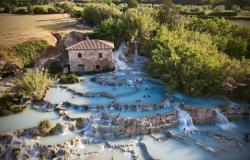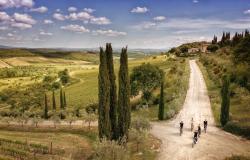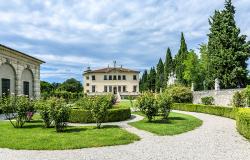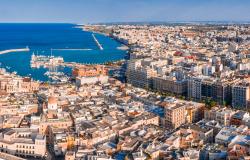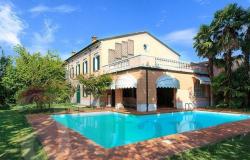On the 150th anniversary of the birth of Italian writer Gabriele D’Annunzio, Carol King takes a look at his unusual home at Lake Garda.
Set on the shores of Italy’s Lake Garda in Gardone Riviera, Il Vittoriale degli Italiani (The Shrine of Italian Victories) was once home to the eccentric writer Gabriele D’Annunzio.

Surrounded by a large garden with views across the sparkling waters of the lake and the mountains beyond, the spectacular setting make the Vittoriale worth seeing for that alone. However, the beautiful surroundings are a complete contrast to D’Annunzio’s house, which left me feeling claustrophobic because of its plethora of objects, gloomy atmosphere and bizarre ambience.

D’Annunzio was born on 12 March 1863 in Pescara, Abruzzo and there are events throughout Italy in 2013 to celebrate the 150th anniversary of his birth. Lauded for his poetry, plays and novels, D’Annunzio is regarded as one of Italy’s greatest writers. Yet D’Annunzio is a divisive figure because of his Fascist political views and hedonistic lifestyle. D’Annunzio was more than a mere scribe: he was a dandy, womaniser, daredevil, drug user, Fascist propagandist, political activist and World War I hero. Such was his charisma that in 1922, Benito Mussolini funded D’Annunzio’s restoration of the Vittoriale in an effort to keep the writer away from Rome and hence out of the limelight. D’Annunzio lived there in the main building, the Priory, until he died in 1938. The relationship between the pair was complex: both loved la patria and D’Annunzio wrote speeches for the dictator. However, D’Annunzio’s popularity represented a threat to Il Duce’s leadership. D’Annunzio was critical of the Fascist leader’s alignment with Nazi Germany, and Mussolini is said to have been relieved when his friend and rival died.

As you might expect from such a fascinating individual, D’Annunzio’s Vittoriale home is an interesting place. Packed with more than 30,000 books and 10,000 objects, it’s an oppressive place. Every surface in the house, except the kitchen, is cluttered with paintings, furniture, frescoes and strange objets d’art. With its low ceilings and items indicative of D’Annunzio’s syncretism – ranging from Murano glass fruit baskets, Ancient Roman columns, death masks, statues of Buddhas and icons of Christian saints – it’s also a shrine to the man’s narcissistic ego.
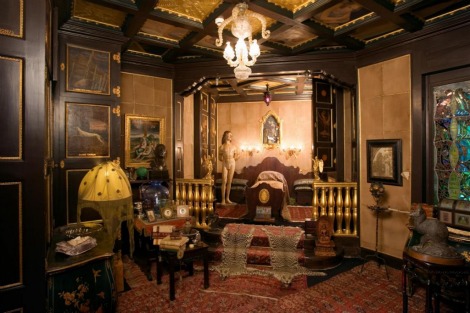
D’Annunzio compared himself to Dante Alighieri and Michelangelo, and each room in the Priory references the artists in some way. D’Annunzio was a man in love with himself and a personal mythmaker. Such was his skill in manufacturing his own image, he created what’s called the ‘Leper’s Room’, where he would be laid out on his deathbed. Complete with a statue of St Sebastian, ancient Egyptian statuary, leopard-skin rugs and a series of steps leading up to a small bed made to resemble both a cradle and a coffin, the Leper’s Room feels akin to an altar with the decadent D’Annunzio as the object of worship.
Such was D’Annunzio’s egotism, he even revised the concept of the Seven Deadly Sins to suit himself. He omitted lust and greed, which he regarded as virtues, to create what he thought of as the only five vices that should be regarded as sinful. The Relic Room contains the inscription: “As there are five fingers on a hand, there are only five mortal sins.”
The low ceilings and darkness of D’Annunzio’s home added to my general feeling of unease, when I visited: it was as if I was inside the nightmarish world of a Henri Fuseli painting. After an accident in World War I, D’Annunzio lost his sight in one eye. In later years, he suffered from photophobia and his inability to tolerate bright light no doubt explains the Vittoriale’s gloomy ambience.
Perhaps D’Annunzio’s inability to spend time outside his home in daylight is why he chose to create his own world by stuffing his house with weird paraphernalia. Whatever the truth, my guide to the museum admitted that the guides dream about the house for months when they first start working there. This is unsurprising, because my tour around the house felt like a visual assault and a journey through the workings of a truly strange mind.

Once I’d escaped from the confines of the house, the grounds of the Vittoriale came as a welcome relief. They house the 1,000-seat Parlaggio amphitheatre, the remains of the ‘Puglia’ battleship cruiser and D’Annunzio’s tomb.
A ring of caskets inhabited by the remains of D’Annunzio’s close friends surround the monument marking where his body lies. It’s an overblown, Fascist-style mausoleum that reveals how D’Annunzio felt he should be revered even in death.
The Vittoriale is one of the strangest places I have ever visited and it was not a pleasant experience. Nevertheless, I’m glad I went there because it gave me an insight into the life of the strange man who popularised the concept of the Black Shirts.
Address: Il Vittoriale Degli Italiani, Via Al Vittoriale 12, 25083 Gardone Riviera, Brescia, Lombardy.
Opening hours: 1 October to 31 March, 9am to 1pm and 2pm to 5pm; 1 April to 30 September, 9am to 7pm.
Ticket price: €8
Website: https://www.vittoriale.it/.
